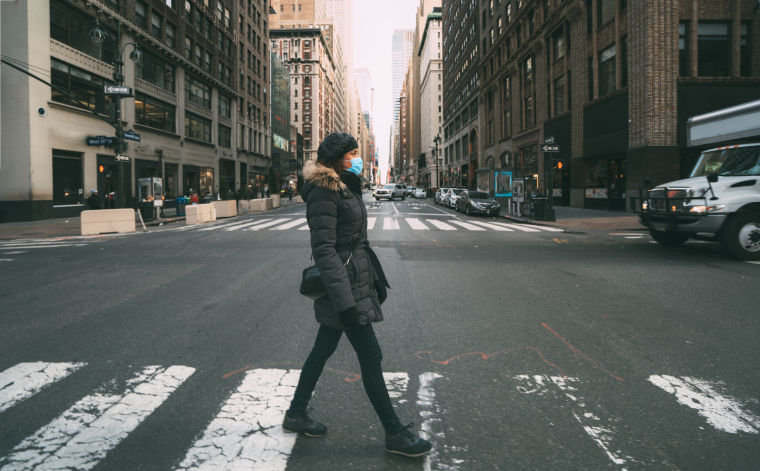COVID-19 December 2021 forecast for the USA
I’d like to say the pandemic ends with humanity learning a valuable lesson in the power to take care of one another.

Article series
COVID-19 impact
- Making healthy habits stick after COVID
- Shobservatory Research Chronicles: Lockdowndiaries
- Capturing early stage consumer feedback, post-COVID
- Evolution of physical space in retail and hospitality
- November 2021 COVID-19 forecast & commentary
- Ethical brands in pandemic times
- November 14 reforecast due to OSHA rule stay
- COVID-19 December 2021 forecast for the USA
- Omicron
- COVID-19 forecast in the USA
- COVID-19 update for the USA
- COVID-19 Omicron retrospective
- Crises and community
- Research that makes a difference
Variants are always the wildcard in forecasting COVID deaths. Variants spread from one person to another and as such, human behavior, characteristics of the virus and time each play a significant role. Consider Delta. It first appeared in December (I wrote about it in my January blog entry and developed the “worst case scenario” on January 15.). Delta took several months before it became dominant. Delta spread because about half the population was unvaccinted, and those unvaccinated didn’t take precautions such as wearing masks or social distancing. 1 in 40 unvaccinated became infected from February through June, For those vaccinated, less than 1 in 700 became infected. (See research with Brown University, Harvard and State of Nevada for more details.) Consider the data from PlaceIQ from June 2021 in Chart 1: Those in low vax counties were far less likely to socially distance. Consider the data I analyzed from Carnegie Mellon University Delphi, which shows that those unvaccinated are half as likely to wear a mask as someone who is vaccinated.
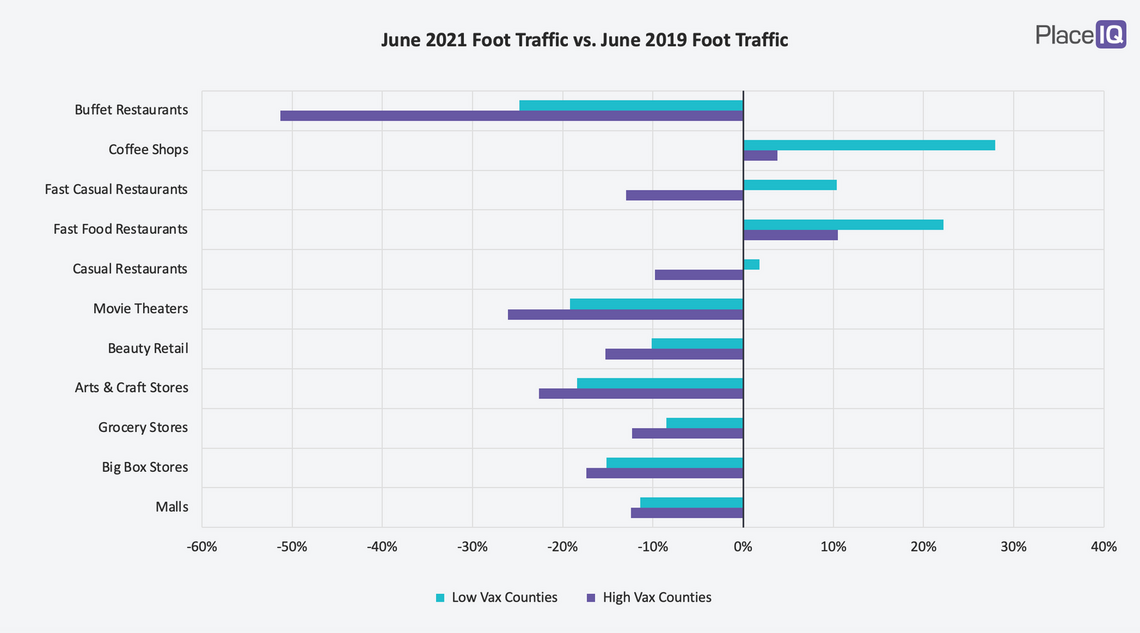
Chart 1: Behavior of unvaccinated vs vaccinated
Delta spread fastest and caused the most deaths in counties and states where vaccination and mask use were lower than the national average. With the behavior of the unvaccinated, it took about six months for Delta to completely take over. In sum, human behavior is the most critical factor in the spread of SARS-CoV-2, and its variants.
Omicron appears more contagious than Delta. If unvaccinated and unmasked continue to behave as they have recently (and there is no reason to expect any change), then we have about three months before Omicron will define COVID-19 forecasts.
As of the first of December, we don’t know if Omicron is more or less deadly than Delta. For our near-term forecast, Delta is the dominant variant and the expected deaths at the end of the year are trending up. I now put the projected year end reported death toll in the US at 823,266 versus my 816,660 projection from just two weeks ago. But it isn’t Delta that defines our projections as much as it is the behavior of the unvaccinated. We really are at the mercy of the unvaccinated and unmasked.
Employers like Tyson Foods, United Airlines, and major universities have required vaccination or testing. These employers have seen vaccination rates increase above 90% - most above 95%. This is significantly higher than the 66% fully vaccinated rate for the 18-64 working age population today. Since the announcement in September of federal government rules for Vaccinate or Test & Mask, my forecast counted on employers of 100 or more people who would require vaccination or testing. Such an increase in vaccination and testing/masking for the unvaccinated would act as a huge brake lever for COVID-19 infections, hospitalizations and deaths.
However, in the US, with the conservative attorneys general in a handful of Red States challenging Vaccinate or Test rules for health care workers and large employers, and Trump appointed judges staying the Vaccinate or Test rules last month, my projection now is for vaccination rates to stall (Chart 2). Based on the judges actions, Brown University and I forecast at least 33,000 incremental deaths from COVID-19 within the next 90 days compared to if these rules had remained in place (and vaccination rates had increased as we had originally forecast).
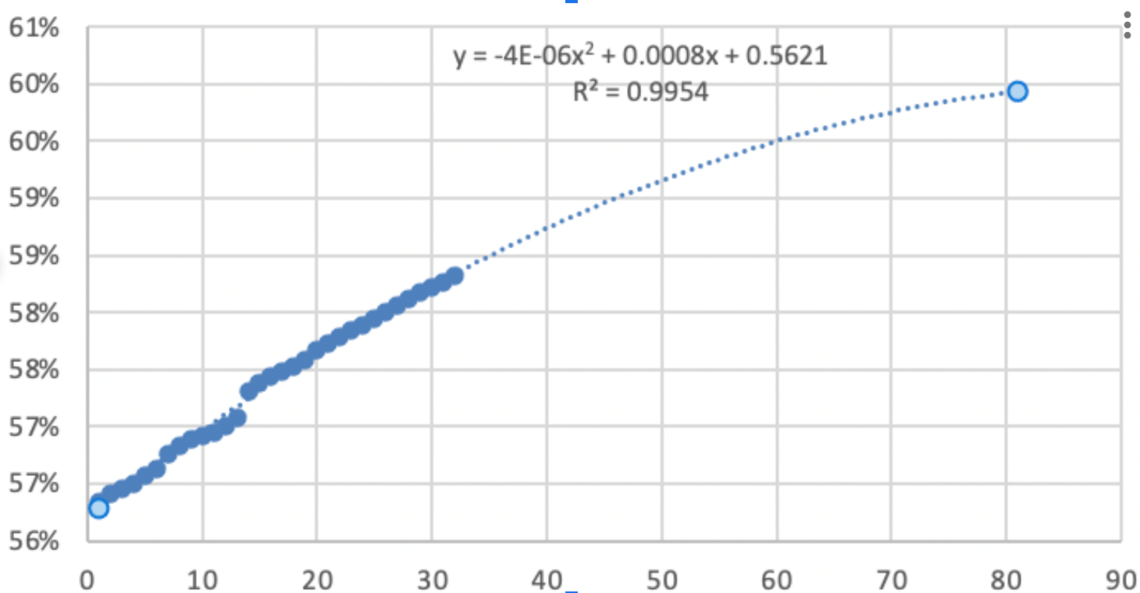
Chart 2: “Only 2pts of vaccination growth expected over next month and a half.”
If you are an employer, or have any influence over one, please consider following through with the Vaccinate or Test without delay. For every 200 employees that become vaccinated, you will save one life and avoid about five hospitalizations and more than 20 cases of Long-COVID in the future. Giving employees the option of vaccination or test and masking seems a reasonable compromise. Testing and masking will also save lives and keep people out of the hospital - not as many as vaccination, but it is a lot better than doing nothing.
When considering the 2022 Forecast, which I have handed off to Brown University School of Public Health, the wildcard is if Omicron will be less deadly or more deadly. The way to track this will be the Case Fatality Rate (CFR) among unvaccinated vs. vaccinated across a range of age cohorts. This is the same method I applied to tracking Delta Breakthrough in Israel through mid-August. Since the average time from infection to death is about three weeks, we just won’t know the direction of Omicron until we are into the new year. Countries with robust genomic sequencing, testing and contact tracing will likely figure it out first. Look to countries like Israel and maybe the UK for earlier insights.
What is clear today: We have a serious health challenge, mounting deaths, and a strained supply chain because of those that refuse to vaccinate or mask. The primary argument I have heard from anti-vaxxers is, “It’s about freedom to choose.”
A well-established American interpretation of freedom states, “your freedom to swing your fist ends where my nose begins.” Freedom does not give one the right to infect and kill others. Judges ruling that lives will be lost if a Vaccine or Test rule passes in hospitals are dead wrong. The evidence is very few people quit rather than vaccinate or test. When one runs the numbers, far more people (33,000+) will die by the conservative judges pen suspending the rules, than the small marginal influence of a handful of health care workers quitting because they refuse to vaccinate or test. The freedom of choice in this situation should be to vaccinate or test. Why should there be a “none of the above” when that choice guarantees more infections, hospitalizations and deaths? How is choosing to leave yourself more likely to become infected and infect others consistent with any theory of freedom?

* Wave Cume from July 1 (604,446). Forecast rate of Vaccine Breakthrough Deaths of 91% in my Model is higher than the rates reported by CDC of 93%.
* Vaccinated % represents two doses. Booster doses are now recommended and the definition of fully vaccinated should change in 2022 to include Booster Doses. This will lower the % reported as fully vaccinated. December forecast was lowered significantly due to Judge stay orders related to OSHA and Health Care Workers rules
Prior to publishing my forecast with Research World and The ARF, I send my forecasts to the COVID Collaborative, Ad Council, HHS, Kaiser Family Foundation, Research Wonks list, my local political leaders, and a few others that requested updates. At times, I’ll get a reply to the effect, “this is sobering.” But here’s the thing: My forecasts are actually optimistic.
If we chart out each forecast versus the actual over the past 13 months, there are generally more deaths reported than I forecast. My one-month forecast is pretty close (2% too optimistic, on average). My three-month forecast has been too optimistic (under the actual reported deaths) by 12%, on average.
In May, when I finalized my three-month forecast for September, I was way too optimistic. Back at the end of Q2, as vaccination rates were rising and masking was still required, I didn’t anticipate that the unvaccinated would be so reckless with their lives and the lives of others. I didn’t anticipate the relentless questioning and undermining of COVID policy by FOX and other conservative media, and how persuasive it would be.
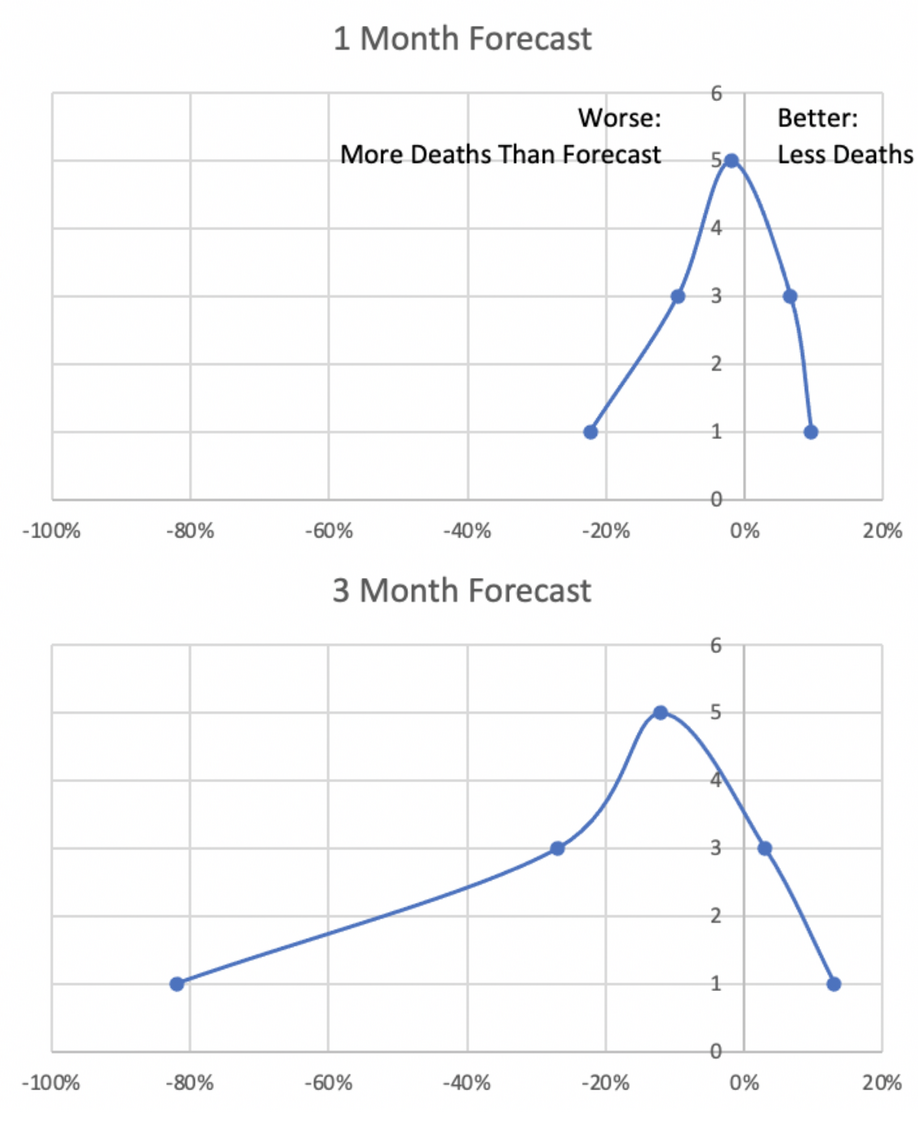
Chart 3: Forecast vs Actual Deaths
While COVID-19 deaths are worse than forecast, this year is not as bad as last year at this time. Chart 4 shows the trend in deaths per million per week as tracked in my dashboard.
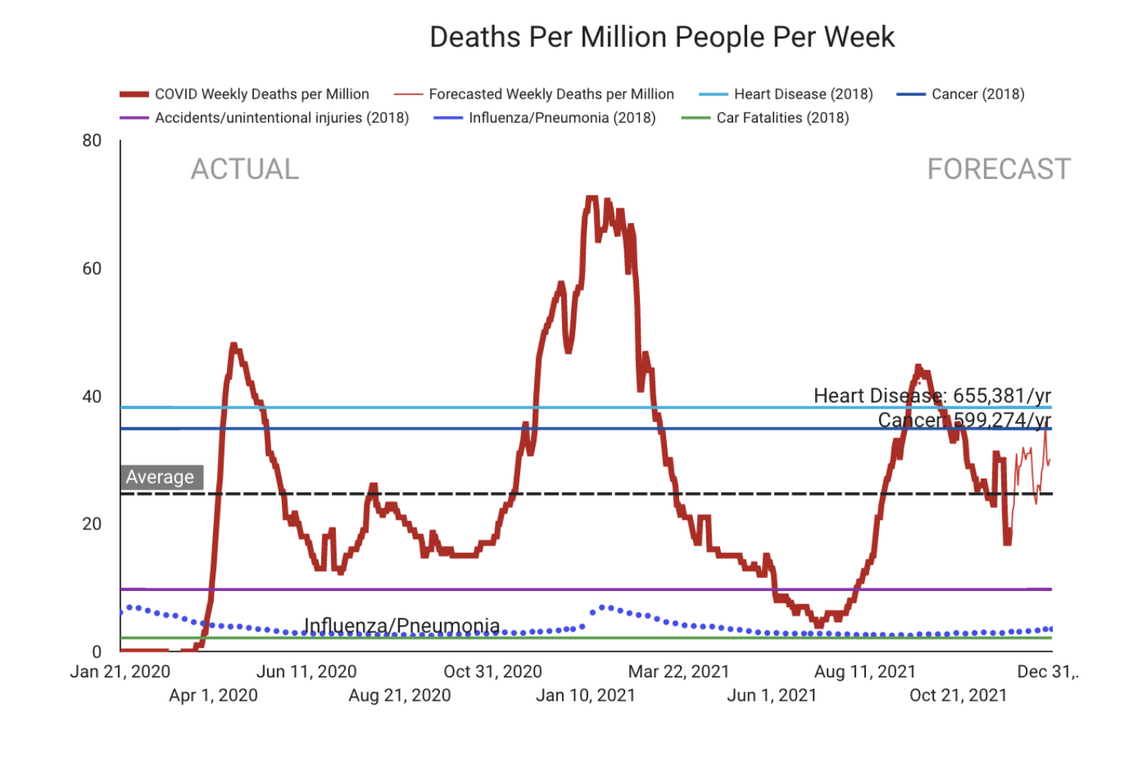
Chart 4: Deaths per Million per Week, US
When one splits the deaths per million per week for vaccinated and unvaccinated, the pandemic is worse this year than last for the unvaccinated (a lot fewer wear masks and socially distance this year compared to last). But, for vaccinated (which are also more likely to wear a mask) the Pandemic is killing fewer than a bad year of the Flu.
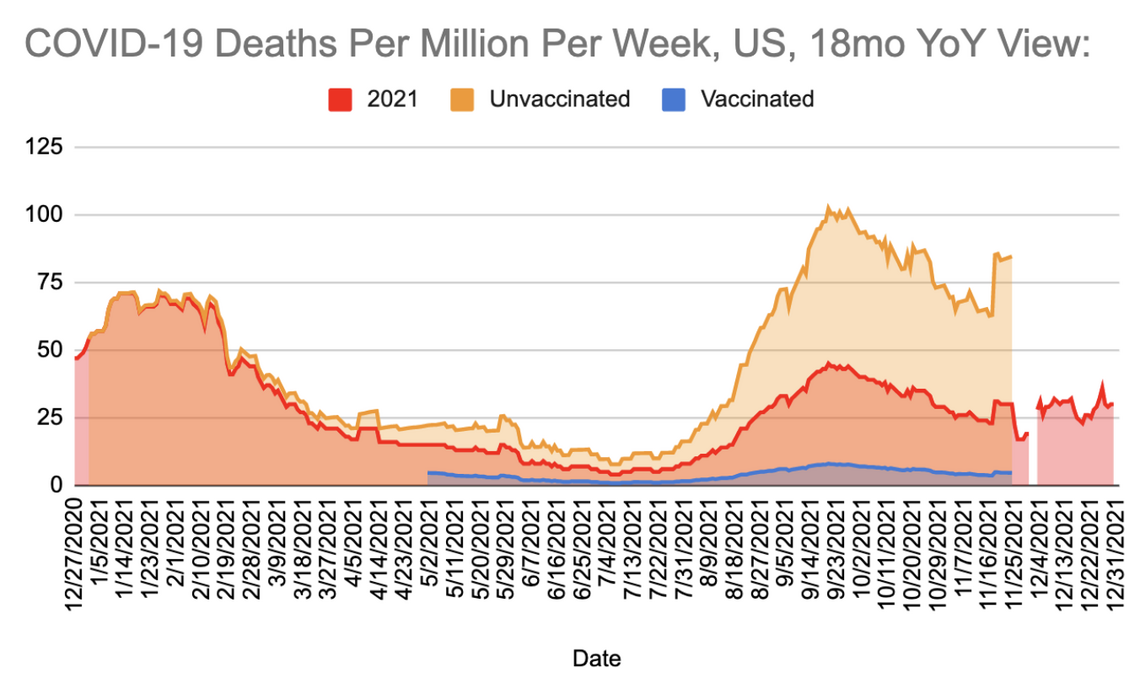
Chart 5: Deaths per Million per Week, trended, vaccinated vs. unvaccinated
My model calculates the growth rate in cases and deaths in relation to my calculation of cumulative immunity (vaccination and recoveries). It is the same pattern today as when I first started to chart cumulative immunity back in January. Increased cumulative immunity places downward pressure on COVID fatalities (chart 6). That’s good news because it means there is an end in sight (unless a variant is more successful at re-infections).
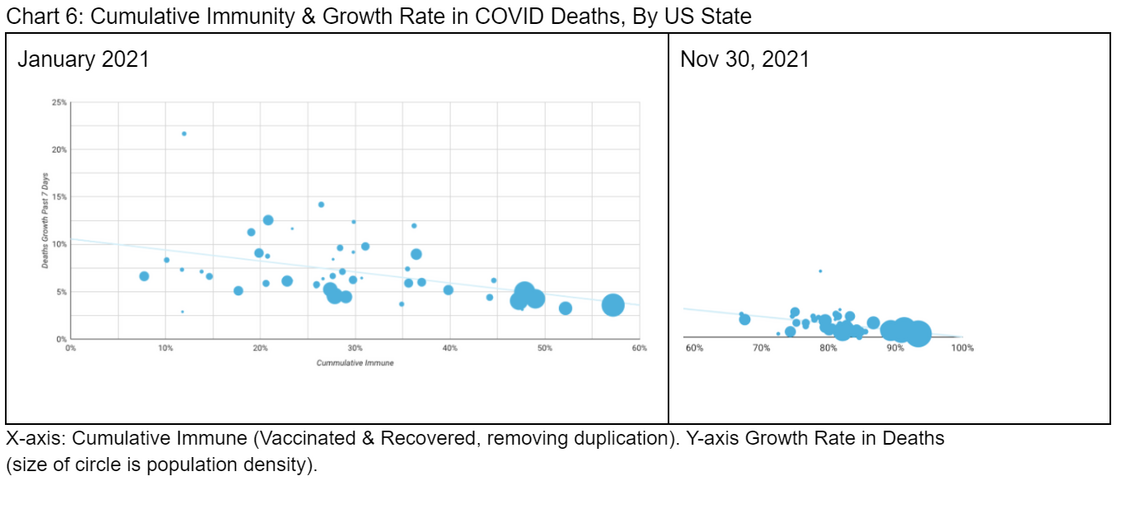
For an interactive view of this chart, see the dashboard pages on herd immunity at www.speakerrex.com. Brown University’s Sameer Air-Desai improved on my chart and shares it with the GlobalEpidemics.org community.
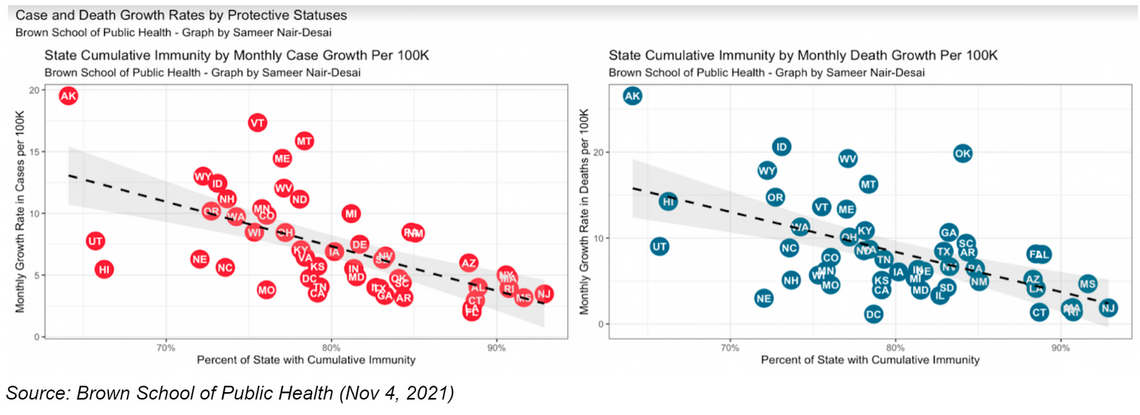
It is important to understand that many states and counties are far behind on cumulative immunity. Wyoming shows cases and deaths taking off right now. Looking at the bottom of chart 7, the states with the least amount of cumulative immunity (Utah, Alaska, Hawaii, etc) have greater risk of case and death growth and will depend heavily on human behavior to control the virus.
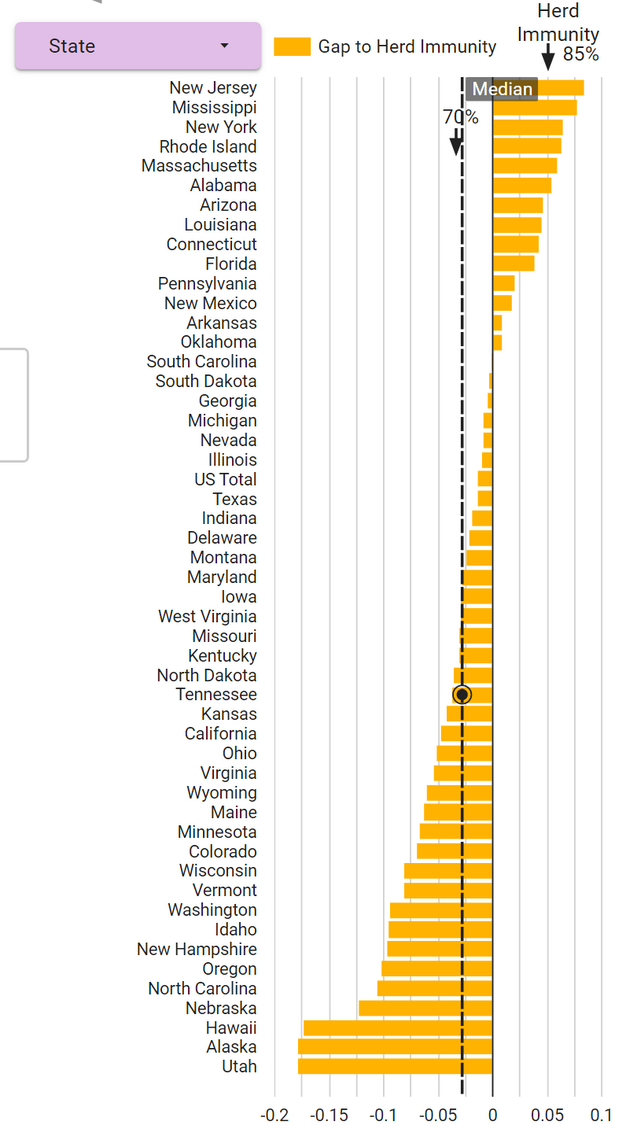
Chart 7: Cumulative Immunity by State
Poorer countries need more support. For countries with less access to vaccinations, much of the immunity is based on infection recovery. Therefore, variants like Lambda and potentially Omicron that have higher re-infection rates are particularly problematic. In addition, countries with less vaccine access tend to have younger populations. So far, COVID has killed an older population, on average. Variants that are more deadly to younger cohorts would be particularly problematic for countries with less vaccine access. Vaccinations remain, by far, the fastest, least deadly and least costly way to end the pandemic.
How Does This Pandemic End? Does it End?
We are getting close to the point where enough of the unvaccinated have gotten infected and either died or recovered with some level of immunity. The unvaccinated and previously infected immunity is not as durable as those who have been vaccinated, but, for most states, we should cross a point in Q1 where the combination of vaccinations and infection recoveries (what I am calling cumulative immunity) puts enough downward pressure on the virus to lower hospitalizations and deaths. But, if Omicron, with all of its mutations, is more successful at re-infection, and those reinfected have outcomes about as bad as the first round of infections, then there will be many more months of unvaccinated filling hospitals and morgues.
Those fully vaccinated, including booster, will do OK, unless a wildcard variant is better at breaking through. But even then, within about 120 days, a new and improved booster can be available in wealthier countries, and those previously vaccinated are likely to get their booster and maintain a high level of protection. Keep in mind, in this wave of 176,397 deaths, less than 15,000 of those are among those with two doses of vaccine. In terms of hospitalization and death, compared to unvaccinated, those fully vaccinated were 20 years older. Vaccines afford a lot of protection. For the vaccinated, the levels of hospitalizations and deaths are less than a bad year of the flu.
As the recent surge in cases in Europe shows, as long as a significant portion of the population is unvaccinated, SARS-CoV-2 cases can spread quickly without masking. Yes, Europe jumped the gun on removing mask mandates, but most European countries are in a better position to reinstate restrictions and control the pandemic. US deaths per million remains above other major democracies in Europe such as Germany, United Kingdom, Italy and France.
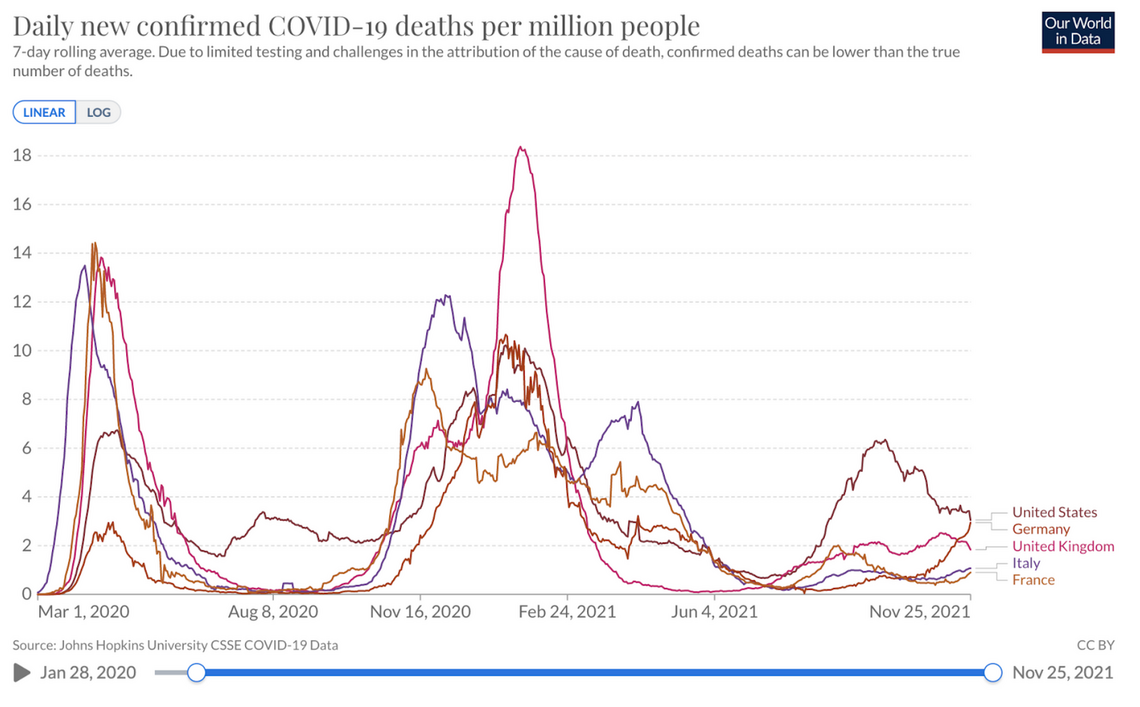
In contrast to European democracies imposing more restrictions to control the pandemic, in the US several states are limiting the ability to impose any restrictions such as allowing employers to require masks, testing or vaccination.
If you aren’t using a N95, or KN94 or similar quality mask, vaccinated or not, now is the time to upgrade your mask. It is also a good time to invest in a few home tests. These can be particularly useful to use before and after extended family visits or travel. Before traveling by car to see my dad in Idaho, a Red State with low vaccination rates and no masking requirements, I packed a fresh N95 mask, and performed a home COVID test. My dad is immunocompromised and was heading into surgery. I will also perform another test after I get home to ensure I am not bringing COVID back to my community.
I’d like to say the Pandemic ends with humanity learning a valuable lesson in the power to take care of one another. I’d like to say we end this pandemic better equipped to deal with other global challenges, like climate change. But it seems more likely the pandemic ends with the science-oriented majority recognizing that there is a minority that will politicize the situation and sabotage solutions thus causing more deaths and destruction. There is a limit to educational programs and facts because there is a lot of money to be made by political media undermining whatever the opposing party is in favor of. Stoking suspicions and outrage seems good for click through and ratings - but not so good for keeping people out of the hospital and the morgue.
Rex Briggs
Consultant and Author at Marketing EvolutionRex Briggs was named one of the dozen “best and brightest” in media and technology by Adweek, and one of the people to “watch and learn from” according to Brandweek. He has been honored with the Atticus Award for his work in direct marketing, the Tenagra Award for outstanding contribution to branding and ESOMAR’s Fernanda Monti Award for his work in CRM. Rex has also won international research awards for his work in understanding website effectiveness and online advertising. His work in understanding the effects of advertising in television, magazine and online was nominated for the prestigious John and Mary Goodyear Award for best international research. Rex was the first director of research for the Internet Advertising Bureau (IAB), and pioneered attribution analytics. His research has been translated into a half-dozen languages and he has taught at leading universities around the world.
Rex is the best-selling author of “SIRFs-Up – How Algorithms and Software are Changing the Face of Marketing.” The book tells the story of how brands can better optimize advertising spend with equations known as “Spend to Impact Response Functions” (SIRFs) and how they will become an integral tool for marketers of every size and vertical for allocating budgets and forecasting business results. Rex also is the best-selling author of “What Sticks: Why Most Advertising Fails and How to Guarantee Yours Succeeds.” The book draws learning from ROI measurement from 36 major marketers. The studies were designed by Marketing Evolution to track media expenditure in real time and offer solutions on how marketers can improve ad effectiveness. “What Sticks” was named the #1 marketing book by Advertising Age, and was featured on CNBC, Bloomberg, CNN, NPR and The Economist. Rex is an instructor for the Association of National Advertisers’ (ANA) School of Marketing, where he holds workshops on ROI measurement technologies and IMPACT Marketing.
Rex founded Marketing Evolution in 2000 and sold his interest in 2019. He is an independent consultant and author. Rex is known as one of the world’s leading experts in marketing ROI measurement and optimization technologies. His expertise derives from direct experience measuring and improving the performance of a wide range of marketing programs for more than 100 Fortune 500 marketers.
Article series
COVID-19 impact
- Making healthy habits stick after COVID
- Shobservatory Research Chronicles: Lockdowndiaries
- Capturing early stage consumer feedback, post-COVID
- Evolution of physical space in retail and hospitality
- November 2021 COVID-19 forecast & commentary
- Ethical brands in pandemic times
- November 14 reforecast due to OSHA rule stay
- COVID-19 December 2021 forecast for the USA
- Omicron
- COVID-19 forecast in the USA
- COVID-19 update for the USA
- COVID-19 Omicron retrospective
- Crises and community
- Research that makes a difference

